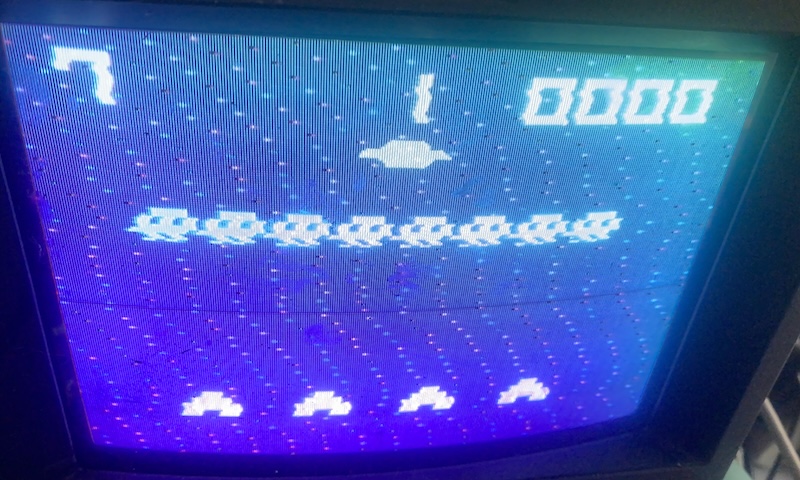The Epoch Cassette Vision: Definitely Not a Pong Console in a Trenchcoat
The evolution of consoles from single-game systems like the Magnavox Odyssey 100 to cartridge-based systems like the NES wasn’t a simple process. The original console, the Magnavox Odyssey, had something kind of cartridge-like despite having no CPU, ROM, or RAM. And the original Japanese cartridge-based console had more in common with the single-game TV Vader than you might think. It’s cassette time, with no magnetic tape reader required.
Not unprecedented
In 1977, a series of game consoles based off of the General Instrument AY-3-8600 series started to show up, especially in Europe. In fact, several consoles showed up, with differing cartridge slots, but all based off of these same chips. We tend to call them the PC-50x family. But the AY-3-8600 games are internal to their chip; therefore, the systems have very little internal logic. AY-3-8600 games are digital logic but no internal microcontroller or ROM.
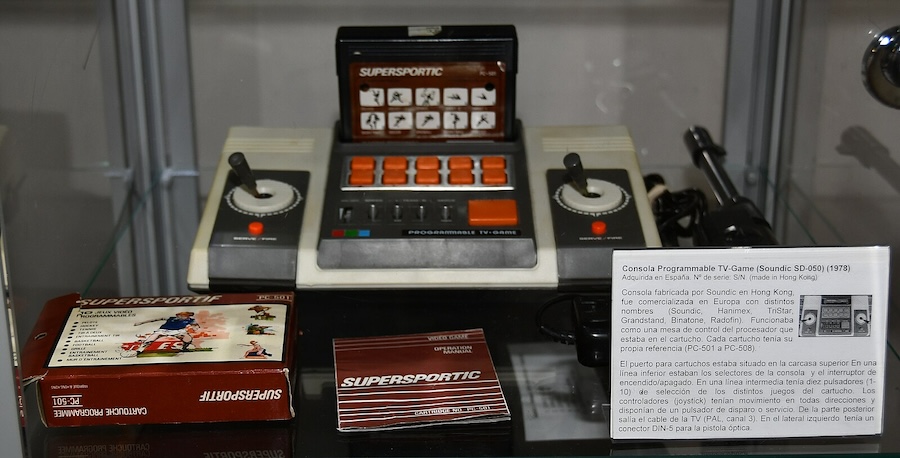
Several PC-50x-type consoles made their way to Japan, like Bandai’s TV Jack 5000. (Watch this space) But they’re not really at all remembered there, and even though they’re from companies like Bandai, because they depended on chips designed by US-based General Instrument for all of their gameplay, they don’t get much credit for the first Japanese multi-game cartridge-based console. That belongs to Epoch.
What is Pong?
There is a concept called “Pong consoles”– single-game consoles that provided games that were kind of like Pong, using a single chip or at least a dedicated Pong-specific motherboard. But this actually masks a bunch of options here.
- Analog Pong - The Magnavox Odyssey, Odyssey 100, etc. Vertical and horizontal offsets, positions, etc stored as analog voltages and capacitor discharge circuits. Ralph Baer’s original “brown box” was apparently even implemented using vacuum tubes for that warm analog Pong feel. I don’t thing any of these were actually Pong-branded; Atari’s first Pong was already in the next category.
- Digital Pong - Series of integrated binary counters. The Odyssey 500 was a digital-ization of the older analog Odyssey 100. The General Instrument games-on-a-chip and the Atari Pong arcade (discrete logic chips) and their Home Pong Pong-on-a-chip games fell into this category. Note that these are still hardwired logic, even if that logic is on an IC.
- Microcontrollers - An internal processor unit runs through a program. This can still be a highly optimized device for Pong, mind you. The MOS 7600-series of Pong-on-a-chip games are confirmed to be in this category, but if you read the post, you’ll see that the paddles are still implemented mostly in hardware, without much work from the program.
The big problem here is that confirming which category each game belongs to requires disassembling the game console, and then also decapping the console’s chip and reverse-engineering the logic. Decapping chips and then decoding a circuit is beyond the scope of this blog, so we just call them all Pong consoles. For example, I don’t know how the Mitsubishi chips behind the Nintendo Color TV Games worked.
Epoch were already doing the third category, full microcontrollers on a single chip. Again I want to stress the existence of his website, chip designer Tetsuji Oguchi’s own notes.

The first uses of this µPD777-series were for single-game systems like TV Vader above (powered by the µPD774C), but this new console would use the same single-game chips, but placed in cartridges like the PC-50x systems. The same controls would be used for all games, but the brain would be in the cartridge.
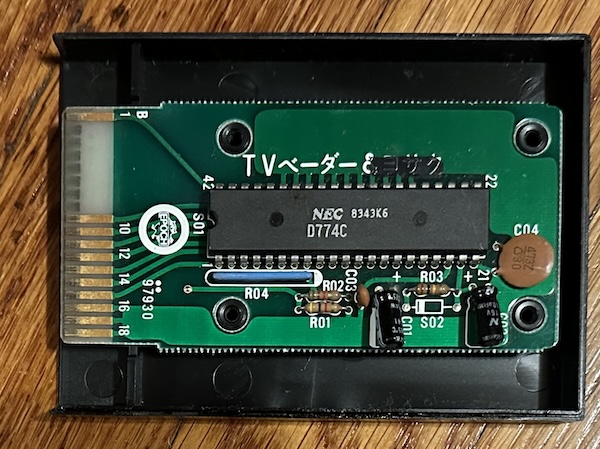
Here’s the inside of the Cassette Vision game cartridge Battle Vader, released in 1982. That µPD774C is exactly identical to that that was used in 1980’s TV Vader. If that “83” next to NEC is part of a datecode, they were still making new chips to the specification, but other commenters have theorized that there were just a lot of unsold TV Vader stock.
Seven hundred and seventy-seven Buttons
So let’s take a step back. Before TV Vader, Epoch had released a few other single-game consoles: the Magnavox Odyssey-like Electrotennis, and then the System 10, a Pong-clone somewhat less Odyssey-like, which was expanded on in partnership with NEC for the unreleased Super 10. Actual releases of games using the chips got started in earnest with Epoch’s Baseball, released in 1978.

For comparison, here’s the TV Vader.

The key thing to notice between all of these game consoles is that they have very different controls. System 10 used two round potentiometers for each player’s X and Y motion, with a plug-in for the optional lightgun, and presumably Super 10 was the same. Baseball used a single round potentiometer, a whole bunch of buttons, a linear multi-position switch, and a lever. TV Vader just needed a few buttons and a lever.
So when it came to making a multi-game console, Epoch wanted to accomodate all these different playstyles, so they could release the same game. And so behold, the Epoch Cassette Vision:
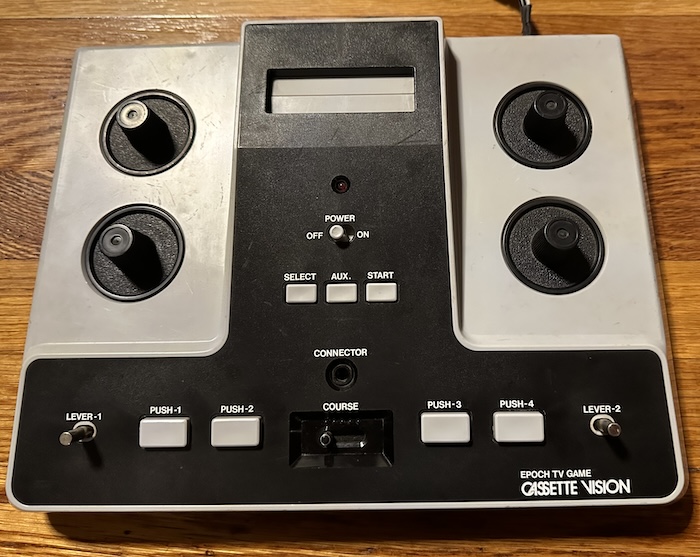
Kind of hilariously with how many methods of control are present, they missed a big one. Notice the complete lack of a joystick, or any form of four-direction digital control. You might know four-direction digital control as being the dominant form of controller input on the Atari 2600, the Nintendo Entertaiment System, the Sega Master System, the Atari 7800, the Super Nintendo, the Atari Jaguar, and still common even on consoles today.
There’s one other thing that’s a little weird about this. Look at the timeline:
- 1975 - Epoch’s TV Tennis Electrotennis
- 1976 - AY-3-8500-based consoles start coming out in the United States
- 1977 - Epoch’s System 10, Nintendo’s Color TV Game 6 & 15
- 1978 - Epoch’s TV Baseball, Bandai’s TV Jack (PC-50x), Nintendo’s Color TV Game 112 (a driving game)
- 1979 - Epoch’s TV Block and Nintendo’s Color TV Game: Block Kuzushi. Epoch also starts limited imports of the Atari 2600 to Japan, as the Cassette TV-Game
- 1980 - Epoch’s TV Vader, and Nintendo’s Computer TV-Game (likely an actual CPU, ROM, RAM game)
- 1981 - Epoch’s Cassette Vision releases, with games coming over the next few years
By 1981, the tech in the Cassette Vision cartridges was three years old, and that was three years in which a lot happened in gaming. But development of these games was agonizingly slow. We have a good description of the development of µPD777 games, thanks to the interview with Masayuki Horie. NEC provided just one prototyping machine, so they were forced to develop games basically one after the other. (Compare to the early days of the Famicom, where all of Nintendo’s R&D teams pumped titles out in parallel)
Horie: Yeah. [The prototyping machine] was huge, about this big (gestures to a large cardboard box). For a terminal it used NEC’s TK-80 computer. There was a separate tape reader attached, and once you inserted your tape it would execute. What was loaded into the RAM there corresponded to what we’d burn onto ROM chips for the actual games.
You might think an advantage of this brain-on-the-cartridge design is that you could upgrade the internals over time with newer titles, but as far as I know, the Epoch-NEC collaboration did not work that way. The Cassette Vision stayed on the market until 1984, but its games were always limited to the specs of the 1978 TV Baseball hardware, hardware that was in fact designed for the Super 10 pong console. We already saw it pushing the limits with TV Vader’s limited number of enemies, and games were rapidly getting more and more complex.
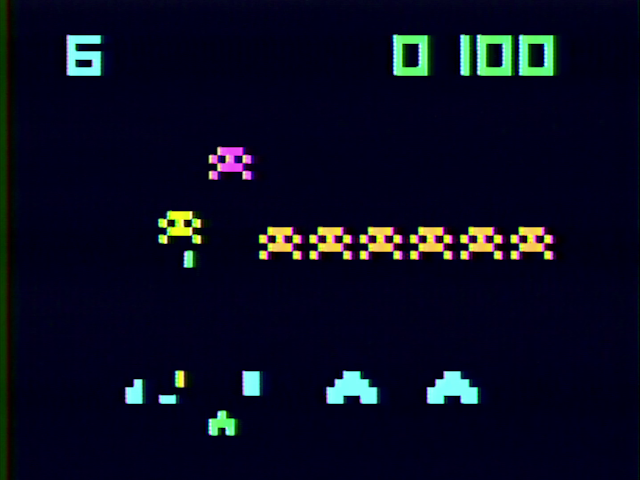
But maybe I’m getting ahead of myself. What are those limits?
The vision foreseen
As noted, the µPD777 is remarkably well documented for an opaque chip die, thanks to Tetsuji Oguchi. We even have an emulator, though it’s Windows-only so I didn’t use it during the work, its source was very useful.
The core Cassette Vision screen is 75x60 dots, and dots can be any of 8 colors, with a global brightness bit, locked to the grid. Sort-of. Dots are not pixels, and can break out of the grid using “bent mode”, which skews them the width of one dot over four scanlines. So you could call this a 300x240 resolution, if you wanted to make it look good.
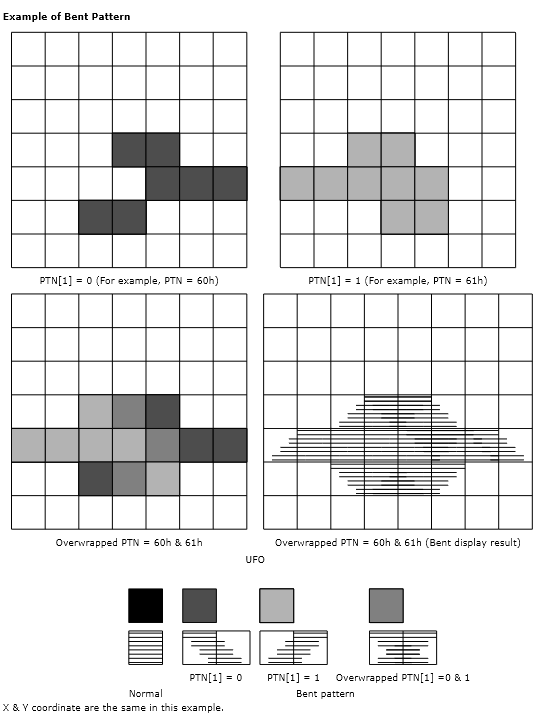
The internal architecture of the µPD777 is a lot like the Neo Geo. Well, okay, it’s not really like the Neo Geo at all, there are at least three major differences. But both build the screen out of flexible moveable elements (I’ll call them sprites, but that term is anachronistic) whose patterns are stored in a separate ROM. In fact, µPD777 goes farther than the Neo Geo, since it has no equivalent to the “fixed mode” tilemap that the Neo Geo uses for scores. Having multiple fast-moving objects on screen is something the Cassette Vision is good at, as seen in Galaxian, which isn’t really Galaxian. (But Namco did still extract some cash from Epoch for it)
Unlike the Neo Geo, patterns are monochrome bitmaps either 7x6 or 7x7, or 8x7, stored in an internal pattern ROM. The command ROM is separate from the pattern ROM, and has a 48-bit bus which allows the microprocessor read an instruction opcode and all of its arguments in one cycle. This is a major advantage of having everything on one die; see the decap done by Sean Riddle for a look at what these look like under the surface.

Unfortunately, the on-screen sprites are limited to 25, which explains why TV Vader was unable to properly recreate Space Invaders. They can, however, interact with other sprites already on screen in different ways, which allows patterns to be reused for different purposes. How sprites interact is also determined by a priority bit the program can set.

All of these sprites are line-buffered, predating Namco’s Galaxian, the game usually credited with the concept. However, the line buffer is also a limiting factor; the programmer must manually specify the patterns to be used by each line buffer while the previous line is being drawn. (You have four scanlines worth of time for this, however) There are two line buffers which are alternated automatically, so there’s no worry about overwriting while the screen is drawing, and also no possibility of raster effects that way.

Raster effects are still a thing, however. I believe the platforms in Monster Mansion are created by changing the background color, and then using sprites to represent the gaps in the platforms.
I also noticed another interesting thing while taking footage of Monster Mansion:
You see that telltale wobble? That’s the OSSC doing some bob deinterlacing. Mr. Oguchi and his team at NEC provided a standards-compliant 480i signal, even though its resolution was so low that nobody would notice. This also means that in theory the gaps between scanlines should harder to see than say, the NES– I couldn’t really confirm this on my Trinitron though even at low brightness, probably because it’s so small. Scanline differences are much more obvious on bigger screens.
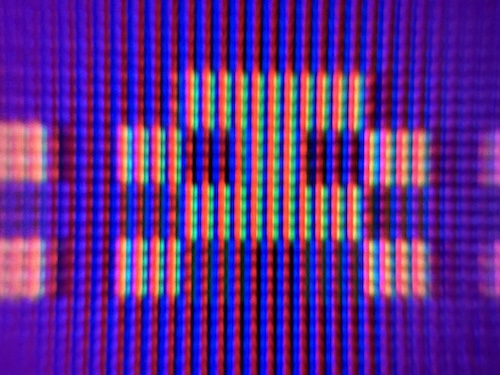
Sound on the µPD777 is also provided internally, with two pulse-wave channels down-mixed to mono inside the chip, that can be set to an 8-bit value corresponding to dividing the line frequency (15.734 kHz), plus an optional reverb effect. Let’s compare this to other consoles of the time; remember though that these had limited if any presence in the Japanese market.
| µPD777 | Fairchild Channel F | Atari 2600 | RCA Studio II | Sony PlayStation 5 | |
| Resolution | 75x60 (300x240) | 104x60 | 160x192 | 64x32 | 7680x4320 |
| Colors | 16 | 8 | 8-128 | 2 | 1,073,741,824 |
| Sprites* | 25 | 0 | 5 | 8 | 20-50 million |
| Sound channels | 2 | 1 | 2 | 1 | 7.1 |
| Sound options | Pulse wave, reverb | 2 tones | Pulse wave, noise | 1 tone | Tempest 3D Audio |
It doesn’t look that bad for the 1970’s, but I think most people are aware of how much the Atari 2600 struggled to keep up with the games of the 1980s (the Channel F and the Studio II didn’t even make it that far), and the µPD777 is a bit more rigid than Atari’s monster– remember, Atari managed to get full columns of invaders on-screen, even if some looked a little weird.

So we’ll definitely have to do a follow-up post to look at some of these games. And if you don’t want to wait for my particular flavor of hot take, you could just watch Jeremy Parish do it.
My Cassette Vision
Now, the astute among you will notice that the picture quality there varies between the assets reused from the TV Vader article, and new footage from Monster Mansion and Galaxian. You might also have noticed the tails sticking out from the Cassette Vision above. One RCA for audio, and an S-Video connector.
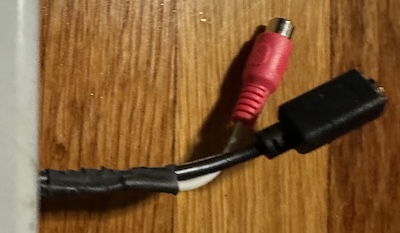
And that’s because my Cassette Vision has had an S-Video modification done. Thanks to Christa Lee at Sound Retro for handling this for me, I couldn’t have gotten this done myself. A particular challenge the Cassette Vision offers is that it operates at negative voltages; the signal is supposed to be modulated in the end so polarity doesn’t matter. It’s an underrated complexity– RF signals are isolated in a way that composite and S-Video signals aren’t, so now you’re making a direct connection to something that wasn’t intended to have it.
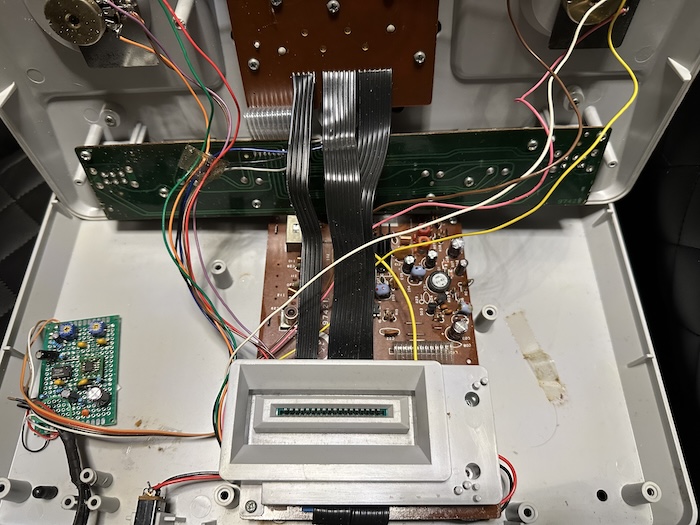
Christa Lee followed the basic guide from the AtariAge forum with her own practice (I had her do this because she also did the mod for Jeremy Parish), using op-amps to invert the signals coming off the cartridge port before converting them into easy to use S-Video form.
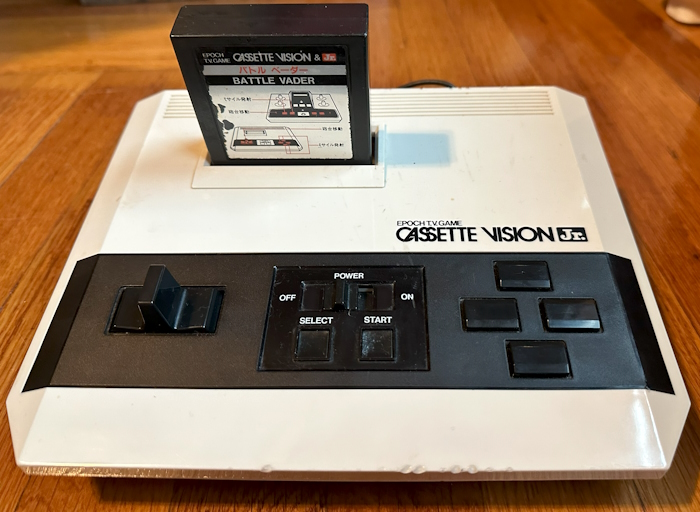
The very astute, however, will remember that in the TV Vader post, I implied a Cassette Vision post was coming by showing a Cassette Vision Jr. The Cassette Vision Jr. was a follow-up done to resolve the big issue I noted: the lack of a four-directional pad. It did this by arranging the four buttons from the original Cassette Vision in a diamond shape; prices were also lowered by leaving off the potentiometers and other features not used by most games– so the Jr can only play eight of the eleven Cassette Vision games.
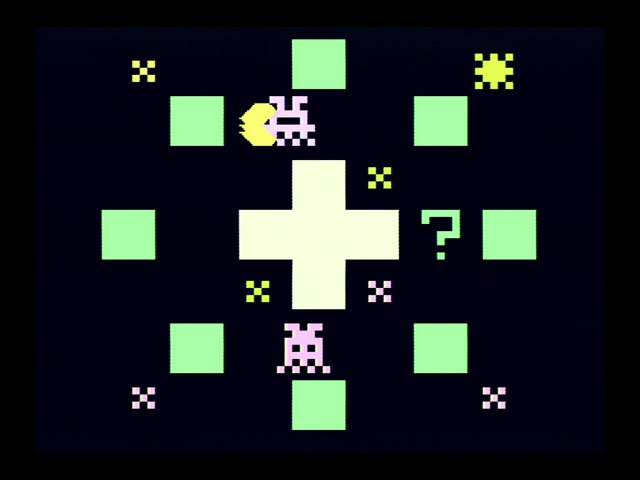
I really wanted to use the Cassette Vision Jr.; one of the games I have for the Cassette Vision is PakPak Monster, which features gameplay similar to yet sufficiently legally distinct from that of Pac-Man, and therefore really wants easy four-dimensional motion. Unfortunately, the same mod when done on the Cassette Vision Jr. creates a number of terrible speckles, apparently due to interference with the audio on the Vision Jr. PCB.
So we ended up doing an arrangement where I paid for the import of another Cassette Vision from Japan and the mod was transplanted into that. That does mean I can use it as another Pong console, though, so definitely look forward to that.

A series on: NEC and Epoch's µPD777 🎰
Digging into the Epoch and NEC collaboration that would bring us Japan's first domestically-developed game console. It's surprisingly well documented!
- How can Space Invaders Invade Your Space? The Epoch TV Vader! — Wherein the TV Vader is discussed-- a standalone µPD777-based console that plays a game similar to but legally distinct from Space Invaders.
- The Epoch Cassette Vision: Definitely Not a Pong Console in a Trenchcoat — Taking a look at the interchangeable cartridge console based around the Epoch/NEC 777-series chips.
- The Epoch Cassette Vision: Has Games — The games of the Cassette Vision! By the early 1980s, this hardware that was too fancy for a Pong console was showing its age. How could it stand out? Having no competition helped, sure...
And as another small thing: apparently despite all those internal buses being crucial, in France, a console Hanimex HMG7900 was put out, which uses the NEC µPD779C; a 777-series chip that can take an external ROM. How exactly it works– cartridges seem to have a single standard ROM chip– is not known to me. I’d love to get my hands on them, but they seem fairly rare and require pricy shipping from Europe, so for now I will do without. (But hey, if you have one in your closet, hit me up)
* - Comparing µPD777 patterns, the Atari 2600's per-scanline sprites, the Studio II's software sprites, and polygons is really comparing apples to oranges to cabbages, but that's the way it goes with such early systems.

